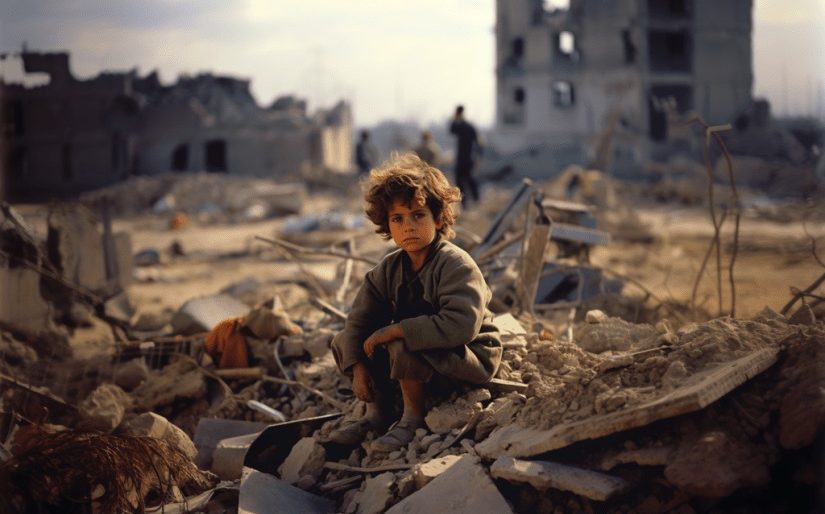This war is being fought with pictures more than words. The poignant shots, often selfies, of families, children, even babies, who were to become victims of Hamas butchery, the wailing mothers and children on stretchers in Gaza, the missile strikes and collapsed concrete buildings. We know politicians on all sides lie, but photography is a mechanical process; these pictures must, surely, be the truth?
Almost all these photos have been taken with mobile phones. To a rough approximation, everybody now has a smartphone. There are said to be seven billion smartphones in use around the world — there are only eight billion people. (Sales of what we used to know as cameras have crashed by 85 percent.)
As far back as the American Civil War photos have been fabricated, usually by shifting corpses around
On these devices, it is said, 93 million selfies are taken daily. People don’t, on the whole, manipulate smartphone shots, but they do post them online as faint slivers of their own truth in an otherwise manipulated world. “These are me,” say the photos, even if the person has already been riddled with bullets.
Some smartphone pictures are grisly images of the aftermath of violence. These are ways of circumventing the reluctance of the old, familiar media to show the most graphic images of war. Precisely because of their forbidden quality, we feel these must be the truth.
But never such innocence again. I asked Tim Marshall, war-hardened correspondent and distinguished author, about the truth or otherwise of all this. “This is not the first conflict in which mobile phone pictures have featured, but it’s the first in which so much horror has been live-streamed or uploaded and seen by so many.”
But after this war is over, the horror, innocence and honesty will be lost. “This may also be among the last conflicts in which images, such as those of the brutality on show on October 7, can be confidently believed. We will soon need seriously high-tech tools to tell us what is real and what is AI-generated.”
Technology cheats, and increasingly often simply lies. Sometimes benignly, as in art photography. This was most spectacularly and well meaningly demonstrated by Boris Eldagsen when he won a photography competition. He declined the prize because this was not a photograph, it was an AI-generated image.
But spend a little time on the AI-image generator Midjourney and you will see the less benign possibilities of this new tech. Midjourney produces images on demand. When the writer Sean Thomas was recently playing around on the site, attempting to create plausible AI fakes, he discovered something quite disturbing. Among the verbal prompts that the platform was offering — prompts that indicate what images other users have been asking Midjourney to create — he came across the following:
a color photo of a single child sitting in destroyed house rubble in Palestine, a hauntingly beautiful portrait capturing the resilience and innocence of a child amidst the devastation…
“Who is asking for an image like this? And why?” wondered Thomas. “Could it be someone hoping to create images that they can later pass off as real?” The “photo” that this prompt elicited was almost entirely convincing.
In truth, however, photography has never been wholly innocent. In the days of film, photographers were adept at darkroom alterations. These quiet enhancements, improvements on the limitations of the cameras of the time, seemed harmless enough. More dubious was the way some shots were staged, turning them into theater.
Perhaps a world in which the photograph is liberated from conveying facts is a better one
Robert Capa’s sensational Spanish Civil War photo of a soldier being shot — legs crumpling, arm with rifle flung wide — was said to be the most moving image of the 20th century. It is now generally agreed to have been staged. The soldier did die but elsewhere and in less heroic circumstances.
Photographers have been cheating since the camera’s infancy. As far back as the American Civil War photos have been fabricated, usually by shifting corpses and cannon balls around to make a more satisfying composition than mere violent death ever could.
Definitely staged was Joe Rosenthal’s photo of marines hoisting the US flag in 1945 on the Japanese island of Iwo Jima. The flag was certainly raised but Rosenthal later rearranged the soldiers into more thrilling postures, a victorious image that has been remade for postage stamps and sculptures.
The point about these shots is that they were intended to look real. One entirely forgivable exception is a manipulation by our greatest living war photographer, Sir Don McCullin. In 1968 he took a picture of a dead Vietnamese soldier with his possessions — bullets, photographs, etc — arranged around him. Though clearly posed, it was also a very effective expansion of the idea of death. No manipulated heroism here, rather something far more terrible: the now meaningless detritus of a human life. “Everything matters,” McCullin once told me, “everything I look at.”
Other manipulations are simply intended to impress. Nobody emerges from a fashion photographer’s studio looking as they do in life; lighting, make-up and software turn them into idealized versions of themselves. Anything but the truth. “The moment an emotion or fact is transformed into a photograph,” said the studio photographer Richard Avedon, “it is no longer a fact but an opinion. There is no such thing as inaccuracy in a photograph. All photographs are accurate. None of them is the truth.”
We have now moved on even from that excess. Teenagers apply make-up and put on just the right clothes in order to take selfies designed to catch the attention of an effectively infinite audience on Instagram. Here is a further loss of innocence, the do-it-yourself glamour shot.
“That taking a picture of yourself,” writes Will Storr in his book Selfie, “and displaying it to the world for comments and likes has become such a lasting phenomenon says a great deal about who we have become.”
To say that photography has lost its innocence — an innocence born of the photographic genius of Julia Margaret Cameron or Eugène Atget — is to wildly understate the issue. From Cameron we can be fairly sure that this is what Tennyson looked like; from Atget that this really is Paris.
“The Daguerreotyped plate is infinitely (we use the word advisedly) more accurate in its representation than any painting by human hands,” wrote Edgar Allan Poe. Alfred Stieglitz, the supreme photographic aesthete, went even further: “In photography there is a reality so subtle that it becomes more real than reality.” In war such subtlety is liable to go unnoticed.
The manipulative process, then, far from being a modern development, is, in fact, a throwback. Current photography, in becoming entirely plastic and malleable, is moving back to the realm of painting, an aestheticized interpretation of the subject.
But to go back to the war, does this mean we have to accept that photographs should never be mistaken for the truth? And that we must rely instead on AI to establish the facts of the case? Artificially intelligent software is now available that will detect AI manipulation of photographs — robots in pursuit of robots. As Tim Marshall says, only high-tech tools will lead us out of the confusion.
Or will it? Israel produced photographic proof that they did not attack the Al-Ahli hospital in Gaza; others, with equally sophisticated-sounding technology, claim to have proved the opposite. Nothing was resolved so we are condemned to believe nothing more than what we want to believe, a grim and deadly prospect.
Deadly because those family selfies, those wailing mothers, those blood-soaked babies will continue to intensify our feelings, to confirm our prejudices. Competing AIs will make opposing claims on the truth. Justifications for slaughter will always be available. The AI gods will never ease our pain. “We will only compound the horrors,” wrote Michelle Goldberg in the New York Times, “if we pretend to be instantly certain about them.”
So perhaps we should give in to the confusion. Welcome the triumph of what the artist Hito Steyerl has called the “poor image.” Embrace the unreliable and unverifiable. Perhaps a world in which the photograph is liberated from performing the role of conveying fact is a better one: more humble, less judgmental. Less dangerous too. War after all thrives on certainty. If no photo can be trusted, no photo can be exploited.
The death of trust doesn’t mean the death of photography. All those Renaissance crucifixions or the Goya horrors are as terrible as they are beautiful. But they do not claim to be the literal truth. Perhaps, in the end, journalistic photographs — or whatever they are called in the future — will just have to be similarly accepted as possible truths and photojournalists, like painters, will become image-makers rather than seekers after documentary fact. This is perhaps not such a terrible fate.
This article was originally published in The Spectator’s UK magazine. Subscribe to the World edition here.


























Leave a Reply